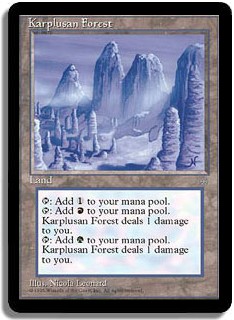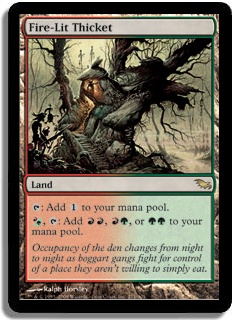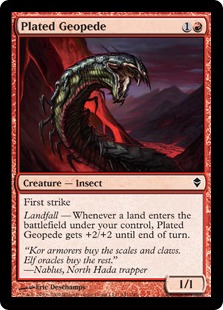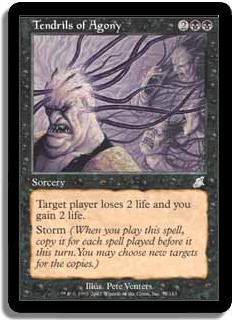Last Tuesday, there was a long-awaited update on the official Wizards of the Coast website which had many Cube enthusiasts abuzz, as well as many people with only a passing interest in the format. This announcement stated that Cube is officially coming to Magic Online. Many people speculated as such when phantom events were announced for Magic Online, and it was only a matter of time once WotC registered a trademark for “Magic The Gathering: Cube” last September. In this article, I’ll talk about what the announcement entails and some initial impressions of the Cube list itself.
When the announcement was posted, some people were unhappy because it meant that the only available option for Cube drafting was through the WotC Cube. Thea Steele talked about using tappedout.net and Magic Online for Cubing online here, but many have been wishing for an official way to Cube on Magic Online and were unhappy that they won’t able to use their own cubes. On his blog, Ted Knutson addressed those and other thoughts about the Magic Online Cube announcement.
I know that the main draw of Cube for many people is about designing one’s personal cube. Therefore, by using a homogenous list you’re taking a lot away. However, not everyone wants to play only with their personally designed cube. I’ve gone to various events and have played with many peoples’ lists. So long as there is thought given to the format, the cube’s “metagame” is well balanced, and the experience is good, I’m more than happy to draft it. Granted, I’d be lying if I said I haven’t created my own cube with my own vision. I’ve spent many hours tinkering with my cube, and writing about designing cubes has been testament to that. However, it isn’t the be-all-end-all of Cubing.
The drafts themselves being 4-3-2-2 single elimination is a bit worrying; I find that people newer to the format (and even people who have cubed for a while) tend to get scared of trying new things in Cube. The drafts being non-Swiss will strengthen that. If someone new to the format were to draft the WotC cube and get beaten severely (especially if the person made a bad deck, like the Isamaru, Hound of Konda + Akroma, Angel of Wrath aggro special), then they may think that the format is bad and “too broken,” like people thought of Eternal formats before they really learned about them. In one of my first cube drafts, I drafted a terrible G/W midrange deck and got crushed, but I was able to get more experience and learn from the subsequent games. If I got knocked out round 1 and was thus unable to play any more games, I might not be writing these articles. I may have just given up on the format and likely wouldn’t be playing Magic anymore. Â
Regarding the concept itself, the temporary implementation will probably be a “pilot” to see how the system works with factors like processing requirements and bandwidth to see if it’s feasible to roll out to individual users. I’ve heard people speculating about WotC charging a price for “licensing” out the ability to do phantom drafts. I doubt that will happen, but if it does, the temporary pilot period will help WotC to determine what costs are needed for that. However, I think it’s just a matter of time before we have the ability to host online Cube drafts through Magic Online’s official client.
I’m personally really happy about the announcement even though I don’t use Magic Online that often. I’ve had problems getting Cube drafts going and know others who have similar problems. If Magic Online Cube hosting is given to individual users, it will definitely help to negate that by arranging games in a software platform that people are used to. But most importantly, online Cube will help to raise awareness and knowledge about a format that I’m personally very passionate about and want other people to experience. People have been less willing to bring cubes to major events since some scumbag(s) stole Justin Parnell cube, and making drafts happen online can help to keep someone’s cube in action if they don’t want to take it to events. Â
The list itself was posted on the Arcana page with some initial hiccups. There was no multicolor section, Goblin Guide was in the black section, and there wasn’t Tropical Island to go with the rest of the original dual lands. Once the list was smoothed out, the contents became more apparent.
The list is 720 cards and was developed by Max McCall and Tom LaPille. It doesn’t run any of the Power Nine as well as some other cards like Sol Ring, Library of Alexandria and Mind Twist. Some other cards like Jace, Memory Adept, Bribery, Mana Crypt, and Moat aren’t included either. There’s a thread on MTGSalvation which goes into pretty deep detail on the list, mainly comparing its contents to other 720-card lists.
When I first looked at the list, I noticed some interesting cards like the storm cards (Empty the Warrens, Tendrils of Agony, Mind’s Desire) which stuck out as well as some cards that aren’t typically used in many lists like Show and Tell, Kozilek, Butcher of Truth, and Ulamog, the Infinite Gyre. The list does a good job of showcasing the history of the game through the many archetypes featured in the game’s rich history. I was able to do about 25 drafts of the WotC Cube through a simulation page with some friends, and we saw a lot of different archetypes represented: Mono-Black Beats, U/G Midrange, Mono-Red Burn, U/R Control, etc. Drafting this cube did represent a good amount of Magic’s various archetypes.
When I looked at the list in further detail, I noticed some areas of possible improvement. The Arcana page said that the list would be constantly changing (Armageddon and Ravages of War were omitted from the list initially, but were later put in). Worth Woolpert said that the list was tested in person in the Northwest, but I don’t know the extent of the testing and some of the things addressed may have been overlooked. Regardless, here are some initial impressions.
In one of my earlier articles about Signets and bouncelands in Cube, I addressed Tom LaPille statements regarding the Ravnica Signets and Karoo lands (like Azorius Chancery). Tom controversially removed them from his cube. Since he was one of the developers of the Magic Online cube list, that ideology continued with this cube. I addressed why his statements weren’t necessarily correct for Cube, but as the removal of Signets and bouncelands from his cube are one of Tom’s major talking points regarding Cube, I don’t expect that to change. But, to be honest, I’m not clamoring for the addition of Signets and bouncelands for Magic Online’s cube. It’s that the ideology behind their removal has been taken too far for this cube.
Looking at the 2007 Wizards Invitational Cube, you’ll see that this idea isn’t necessarily without precedent, as that cube intentionally kept mana fixing at a minimum. In Tom’s interview with Aaron Forsythe in late 2007, Aaron said that he wanted mana fixing to be lowered to commit people to colors. Note from the interview:
To this end, they included very minimal amounts of mana fixing non-basic lands. They started with only the cycle of Alpha dual lands and a few other individual standouts, but eventually added Ravnica’s Karoos because of how well they played. There were other individual lands like City of Brass, but no more cycles of lands. Aaron knew that he had succeeded when Stephen Menendian was faced with the first pick first pack choice of Time Walk against Dark Confidant, and ended up picking the Confidant because “Confidant is a better black card than Time Walk is a blue card.” I suggested to him that perhaps mana fixing has less of a distorting effect when there simply aren’t cards on the level of Time Walk to splash, which he thought was reasonable. He said that the amount of mana fixing in a cube is really a matter of taste in his opinion, but he was happy with how the Invitational cube felt.”
Additionally, the idea for removing a lot of the non-basic land fixing was done to make green known as “the mana acceleration and fixing color.” It’s a well-intentioned idea to help identify and define green’s role in Cube. Green can find itself lost as not being a primarily aggressive or control color (red/blue, respectively) or a support color like black or white. At least in theory, making green the almost sole source of mana fixing and acceleration lets people know that the green decks are the ones that will be able to essentially skip the early stages of development (although I’ve found that green is able to compete well in terms of fixing and acceleration even with other competition). However, the good intention of making green the mana fixing/acceleration color were taken too far for this cube. The most noticeable pitfall that I’ve noticed in the list when doing simulation drafts is that the mana fixing is the biggest issue in that cube (data coming from having drafted the cube approximately 25 times with mostly other humans as the bots on the site tend to draft poorly.)
If you look at the list, you’ll notice that in addition to not running the Signets/bouncelands it also doesn’t run the Mirrodin Talisman cycle (Talisman of Dominance) or even Manalith and Darksteel Ingot. Again, it’s understandable if the intent is to identify green as the mana fixing and acceleration color. However, non-basic land mana fixers are also pretty anemic in this format, as the only available ones are the original duals (Taiga), the Ravnica duals (Stomping Ground), the Onslaught/Zendikar fetch lands (Wooded Foothills), the M10/Innistrad dual land cycle (Rootbound Crag), and the Worldwake manland cycle (Raging Ravine) in addition to a few other lands like Thawing Glaciers. While this has resulted in people not being able to carelessly splash for cards, non-green decks have very cumbersome mana bases. It’s especially apparent in aggressive decks. To quote Kenny Mayer:
Control decks don’t suffer as much because they have time to set things up and can afford to wait to cast things. Green decks have access to other types of fixing, but non-green aggro decks don’t have that luxury. This was especially apparent in the simulated drafts, as there were decks that had abysmal mana bases through no fault of their own because the fixing just wasn’t there and the excuse of “pick your lands higher” didn’t apply. It got to the point to where people were taking fixing extremely over almost anything except for extremely powerful cards because they wouldn’t know when they’d be able to get another non-basic. In one of the drafts, an aggro deck took a fetch land over a Sword of Light and Shadow and given the lack of available fixing, that pick was almost assuredly correct!
This problem also compounds when there are two players in the same color pair. There was a draft where two people drafted Boros aggro, but one of the decks had to run the all-basic-land-special because the fixing wasn’t there and the other had a miser’s Sacred Foundry. Did those Boros decks deserve to have awful mana bases just because they weren’t in green?
It’s also contradictory with the multitude of multicolor cards, especially tri-color ones like Cruel Ultimatum and Doran, the Siege Tower. We found that unless you were in green, drafting tri-color decks was nearly an exercise in futility unless you were drafting a dual-color deck with a splash (like splashing Nicol Bolas, Planeswalker in a U/B/r shell, as splashing for something like Doran is just awful). The lack of fixing was also apparent when seeing those tri-color cards later in the draft, as no one wanted to jump into a third color for the red/blue side of Cruel Ultimatum as there was almost no way to get the fixing to make that pick worth it. The tri-color cards were almost always late picks, but seeing something like a Cruel Ultimatum, Sprouting Thrinax, or Ruhan of the Fomori in pack 2 or 3 all but sealed their fate to be last picks. The cube could do with cutting some of the excess multicolor cards since there are some weak two-color cards.
I know that they don’t want people to “solve the format” by just algorithmically taking fixers and forcing Five-Color Control due to an abundance of fixing, and I can’t blame them one bit. But even if WotC doesn’t want to include the Signets or bouncelands to help give aggro a chance, it’d be good for them to also consider less control-oriented mana fixing cycles like the Ice Age/Apocalypse pain lands (Karplusan Forest) or the Shadowmoor/Eventide filter lands (Fire-Lit Thicket) to help mana bases. There are other fixers like the Lorwyn Vivid lands (Vivid Marsh) and the Shards of Alara tri-lands (Savage Lands), but those don’t really address the fact that aggressive decks have a harder time competing because their mana fixing isn’t that good. Lands that enter the battlefield tapped (at least ones that don’t turn into creatures) don’t help that cause.
When I initially looked at the list, all of the cube heavy hitters (aside from those that were taken out for power reasons) were there. Jace, the Mind Sculptor? Check. Sulfuric Vortex? Check. Isamaru? Check. Survival of the Fittest? Check! However, looking deeper at the list, I found that there are some deficiencies in inclusions, mainly cards that aren’t heavy hitters: role-fillers and generally solid cards that don’t really come to mind initially when people think of Cube. These are cards that are used in cubes half of the size of the WotC one, cards like Plated Geopede, Viridian Shaman, Kor Skyfisher, and Diabolic Edict / Chainer’s Edict. They’re cards that are like the bass in a band; something that you don’t immediately think of but you know missing when it’s not there.
When I first built my common cube, I forgot to include cards like these in my list. I’m thinking that this may be a case of overlooked cards—when WotC was testing their cube, it’s doubtful that people asked, “Hey, where’s Plated Geopede and Keldon Vandals?” It wasn’t until I looked at the list after draft #20 that I realized that I never saw Plated Geopede and that was due to it just not being in the list.
In a similar vein, there seems to be a lot of CC creatures (like White Knight / Black Knight.) While it may not seem bad if the idea of the cube is to encourage two-color decks, it creates problems for aggro decks by putting a lot of pressure for decks to hit their correct mana, which may just not be possible with the available fixing. Tom’s old cube list stressed using a good amount of 1W creatures in his white section. Making some changes by keeping those oppressive costs in mind, like cutting Goblin Wardriver for things like Hearth Kami (which is still good enough for cube, especially in a cube this size) and Plated Geopede will help those decks.
It seems that a good amount of the cards that aren’t included are solid, aggressive creatures that are common in many cubes. We found that the cube supported one aggro player decently, but once it got to more than that the decks started to suffer, especially if they shared a color (one person going B/W, other person going R/W). There were also some examples of cards that likely weren’t cut for power reasons but aren’t in the list like Phantasmal Image, Crystal Shard / Erratic Portal, Karmic Guide, and Scavenging Ooze. These could just be innocuous omissions.
There are also some cards that look like they were added with good intentions but don’t look like they’re going to work out as well as the designers hoped. The biggest example that I can think of is the storm cards. In our drafts, several people tried forcing storm in various ways and not one person succeeded. I tried in a room full of bots, windmill slammed Tendrils of Agony, and got demolished when I played against a friend’s G/U midrange deck because my deck just couldn’t do anything worthwhile. Even when the guy who forced the Dream Halls deck was unable to succeed even though it’s easier to exploit Dream Halls than storm cards.
It was nearly impossible to get all of the cards necessary to make storm worthwhile, especially in blue where most of the cards like Ponder / Preordain and other such “cogs” will be taken by a blue control deck. The potential upside doesn’t seem to be worth it (I Mind’s Desired for six…now what? How am I going to actually win this game now?) for the slots that they use, especially since there are only two real storm kill cards in the cube (Tendrils of Agony and Empty the Warrens, no Grapeshot). The odds of getting one in your draft are pretty slim.
Limited environments are designed to have “skill tester” cards in the format, and I’m unsure if the storm cards are intended to be like that where people realize that the cards may look promising but just aren’t worth going after because they aren’t as good as they’d thought. I highly doubt that’s the case, as it seems more like good intentions that may not work out as well as they intended.
It’s more likely the “stories” factor, especially if the list being shown at PAX East and the interesting stories will draw people into drafting it (“Oh man, I totally drafted Sneak Attack/Ulamog!”). Again, from the Forsythe article:
Unfortunately, some archetypes look like they didn’t get that much support like the artifact-based deck (as both Tezzerets aren’t included in the list with Grimgrin, Corpse-Born being used over Tezzeret, Agent of Bolas) and decks like Wildfire. There are a lot of Wildfire variants in this cube (including Devastating Dreams), and the lack of mana rocks (and using ones on the weaker side like Fellwar Stone) hurts those archetypes. However, my friend @Azcz had drafted the archetype effectively by utilizing those cards in a R/G Ramp shell.
Creatures (9)
- 1 Solemn Simulacrum
- 1 Eternal Witness
- 1 Yavimaya Elder
- 1 Akroma, Angel of Fury
- 1 Wickerbough Elder
- 1 Terastodon
- 1 Primeval Titan
- 1 Phyrexian Metamorph
- 1 Scorned Villager
Planeswalkers (1)
Lands (5)
Spells (25)

While I’d have included Coalition Relic over Scorned Villager, it shows that the archetype is still viable but only really in R/G, not in types like R/U where the deck was historically used. It’s likely still a good archetype, but the decision to not lack of mana rocks hurts those cards. However, Tinker and Upheaval are still really good, even if it’s harder to abuse them due to the lack of mana rocks. They’re just not as reliant on those artifacts.
Lastly, there are some cards that seem to be underpowered, like Renewed Faith (which frequently was a last pick and never maindecked), Phantasmal Bear (which doesn’t look like it has the support required to make it good), and the sideboard cards. The latter, cards like Flashfreeze and Pyroblast, were mostly last or near-to-last picks. Evan Erwin said on an early episode of The Magic Show that an example of a good cube is that when you see a card fifteenth pick, you’re ecstatic because the card is very good (“How did I get Burst Lightning fifteenth pick?!”) Cards like the hosers fall into this category, but even the weaker tri-color ones like Ruhan of the Fomori and Sprouting Thrinax (great on turn 3, but you’re likely casting it around turns 5-7!) are just going to clog the later picks. While it’s nice that at least those cards may end up serving a purpose rather than a card that just doesn’t do anything, they’re still overall weak cards.
That being said, I’m not trying to be a curmudgeon. I’m not saying that you shouldn’t draft with the list when it goes on Magic Online and that that the list is awful, because it isn’t. It gets a lot more right than it gets wrong. Some of the supported archetypes like Mono-Black are an actual thing in this cube, making cards like Phyrexian Obliterator solid enough of the time to warrant their spots. People typically drafted a variety of decks. I think the list could have some of the more loose edges smoothed out, but I’d still happily draft it!
Justin Parnell said that the WotC Magic Online Cube will be like a gateway drug for people to the format, and that’s what I’m hoping. I’m hoping that the launch will introduce a new wave of players to a wonderful, dynamic, and extremely fun format and inspire them to play Cube more or to even to create their own cubes!
May all of your opening packs contain Sol Rings!*
On a side note, Rueben Bresler, I, and Eric McCormick from MTGCast interviewed Zac Hill about the MTG Online cube. Check it out here!
Download here:
http://traffic.libsyn.com/yomtgtaps/97_Episode_97_-_Standard_Deductions.mp3
@UsmanTheRad  on Twitter
My blog featuring my powered & pauper cube lists:Â http://idratherbecubing.wordpress.com
Cube podcast that Anthony Avitollo and I co-host: The Third Power
*Unless you’re drafting the WotC Magic Online Cube; then may your opening packs contain Grim Monoliths!






